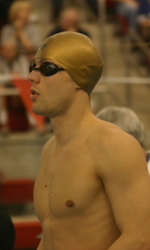Feb. 23, 2011
By Kelly Taylor
The Notre Dame men’s swim roster epitomizes diversity.
With swimmers from Australia, Puerto Rico, South Africa and Serbia, the Fighting Irish do not hesitate to reach across international borders to compile the most competitive group.
Junior Petar Petrovic hails from Pancevo, Serbia. After swimming at the University of New Orleans during his freshman year, he transferred to Notre Dame as the Privateers soon discontinued their program.
“Randy Horner, the head coach at the University of New Orleans was good friends with Matt Tallman, the associate head coach at Notre Dame,” he says. “He recommended the school when I decided to transfer and that’s how I found out about Notre Dame.”
Sophomore Stefan Prendergast specializes in the freestyle and butterfly events. He has roots in Australia and came to Notre Dame in a similar fashion.
“My coach in Australia was originally from Virginia and was recruited to come and coach in Australia,” Prendergast explains. “He was familiar with the American college system and stressed the great opportunity it was to attend a university as a student-athlete.”

Junior swimmer Petar Petrovic hails from Serbia. He was a member of two school-record setting medley teams at the 2011 BIG EAST Swimming Championships.
|
Bertie Nel is a freshman from Tzaneen, South Africa. He competed in two FINA World Cup meets as well as the 2008 South African Olympic Trials. He surfed the web and stumbled upon Notre Dame.
“I always wanted to come to the United States, and by chance came upon Notre Dame,” he says. “And I have been extremely happy ever since.”
Both Prendergast and Nel stepped foot on Notre Dame’s campus for the first time during freshman orientation. According to Nel, he always knew he wanted to swim competitively in the United States.
“Ever since I started taking swimming serious, I knew that if I wanted to achieve my goals in swimming, I would have to come to the U.S.,” Nel states. “I am now one step closer to that dream.”
For Prendergast and Petrovic, they didn’t plan on swimming in the United States until late in high school. Petrovic noticed the cultural differences immediately upon enrolling.
“In Serbia, athletics and academics are two entirely separate institutions,” he says. “I often faced conflicts between school and practices, and if I didn’t come to the U.S. I would have quit competitive swimming.”
Petrovic also pointed out the higher degree of training that he received in the United States. Bertie Nel noticed an extreme difference in training as well.
“Swimming in America is much more intense [than South Africa],” he notes. “We work much harder and much longer, and I am already seeing the results.”
Many international student-athletes face difficulties ranging from time management to socializing to language barriers. Despite the superior level of competition, homesickness continually shadows the athletes. Petar Petrovic notes how he misses his native country of Serbia.
“I get to go home once a year for a few months over the summer, but I feel homesick almost every day,” he says.
Nel also reflects on the 8,000-mile trek separating his home from Notre Dame.
“I have not been back home since the start of the school year, and I really do miss home,” he says. “Especially the heat of the African summers.”
Other notable differences appear within the scope of academics. Petrovic, a political science major, prefers the American approach.
“Serbia has an entirely different educational system than the U.S. Due to lack of infrastructure and adequate organization, it is almost impossible to be a good student and a good athlete at the same time back home,” he says. “Professors have the unquestionable authority and do not allow a lot of debates.”
Similarly, Nel prefers classes in the Unite States. He has also had to overcome a language barrier upon leaving South Africa, speaking Afrikaans while growing up.
“Classes are very different,” he says. “The classes in America are much more discussion orientated, whereas back home they were mostly lecture based.”
Stefan Prendergast studies within the College of Science. In Australia, students enter medical school out of high school as opposed to college.
“The GPA concept is not present in Australia, so that took some time adjusting to it,” Prendergast states. “Most students at Australian universities live at home and commute each day or the days that they have lectures.”
Although they have each adapted to living in America, the men appear to relish in the competitive atmosphere that NCAA swimming has to offer. Moreover, they have found a home away from home on the team itself.
“I was truly amazed at how tight a group we are,” Nel says. “I have never felt team spirit like this and absolutely love it.”
The three international swimmers played key roles in Notre Dame’s second-place finish at the recently completed BIG EAST swimming championships that were held in Louisville, Ky.
Petrovic was a member of two Irish record-setting medley relay teams. The 200 medley relay squad set a school record of 1:28.56 that was good for an NCAA B-cut finish. The 400 medley relay finished in third place in the meet in a school record time of 3:15.10. Individually, Petrovic was fourth in the 200 backstroke, finishing the race in a time of 1:45.75. Nel was eighth in that race with a time of 1:49.01.
And it just so happened that Nel was rejoined with his family at the meet, as they made the trip from South Africa to Louisville to watch the Irish compete.
With the success of this current group of swimmers, the men’s swim team will continue to develop global pipelines and help set the standard for international athletes at Notre Dame.







